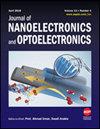Hydrothermal Synthesis of Metal Ferrite Nanocomposites for Energy Storage Applications
IF 0.6
4区 工程技术
Q4 ENGINEERING, ELECTRICAL & ELECTRONIC
引用次数: 0
Abstract
We report on a simple and facile synthesis of manganese ferrite (MnFe2O4) and nickel-manganese ferrite (Ni-MnFe2O4) nanoparticles by hydrothermal method using 2 M NaOH. In this work, the resultant nanoparticles were characterized by using various tools. The X-ray diffraction pattern (XRD), scanning electron microscopy (SEM), and energy dispersive X-ray analysis (EDAX) were studied to confirm the structural and, morphological properties of obtained MnFe2O4 and Ni-MnFe2O4. Electrochemical impedance spectroscopy (EIS), galvanostatic charge-discharge (GCD), and cyclic voltammetry (CV) were used to examine the electrochemical characteristics. The average crystallite size of (MnFe2O4) and (Ni-MnFe2O4) nanoparticles has been found to be 23.75 nm and 17.88 nm, respectively. The morphology of the resultant product was observed to be spherical and semi-spherical in shape. A major component of supercapacitors are their electrode materials, and in order to achieve maximum capacitive performances, electrode material structural design should be emphasised. The electrochemical supercapacitor electrode application of manganese ferrite (MnFe2O4) and nickel-manganese ferrite (Ni-MnFe2O4), thin films deposited onto nickel-foam substrates using the doctor blade method are explored. The maximum specific capacitance values, obtained using galvanostatic charge–discharge plots of as-deposited manganese ferrite and nickel-manganese ferrite electrode in 1 M KOH aqueous solutions at 1 (mA/cm2) is 885 F/g and at 1 (mA/cm2) is 1255 F/g respectively.水热合成用于储能应用的金属铁氧体纳米复合材料
我们报告了一种利用 2 M NaOH 的水热法简单易行地合成锰铁氧体(MnFe2O4)和镍锰铁氧体(Ni-MnFe2O4)纳米粒子的方法。在这项工作中,利用各种工具对所得到的纳米粒子进行了表征。研究了 X 射线衍射图谱(XRD)、扫描电子显微镜(SEM)和能量色散 X 射线分析(EDAX),以确认所获得的 MnFe2O4 和 Ni-MnFe2O4 的结构和形态特性。电化学阻抗光谱法(EIS)、电静态充放电法(GCD)和循环伏安法(CV)用于检测电化学特性。发现(MnFe2O4)和(Ni-MnFe2O4)纳米粒子的平均结晶尺寸分别为 23.75 nm 和 17.88 nm。观察到生成物的形态为球形和半球形。超级电容器的主要组成部分是电极材料,为了实现最大的电容性能,应重视电极材料的结构设计。本文探讨了采用刮刀法在镍泡沫基底上沉积锰铁氧体(MnFe2O4)和镍锰铁氧体(Ni-MnFe2O4)薄膜的电化学超级电容器电极应用。在 1 M KOH 水溶液中,在 1 (mA/cm2) 电流和 1 (mA/cm2) 电流条件下,沉积锰铁氧体和镍锰铁氧体电极的最大比电容值分别为 885 F/g 和 1255 F/g。
本文章由计算机程序翻译,如有差异,请以英文原文为准。
求助全文
约1分钟内获得全文
求助全文
来源期刊

Journal of Nanoelectronics and Optoelectronics
工程技术-工程:电子与电气
自引率
16.70%
发文量
48
审稿时长
12.5 months
 求助内容:
求助内容: 应助结果提醒方式:
应助结果提醒方式:


